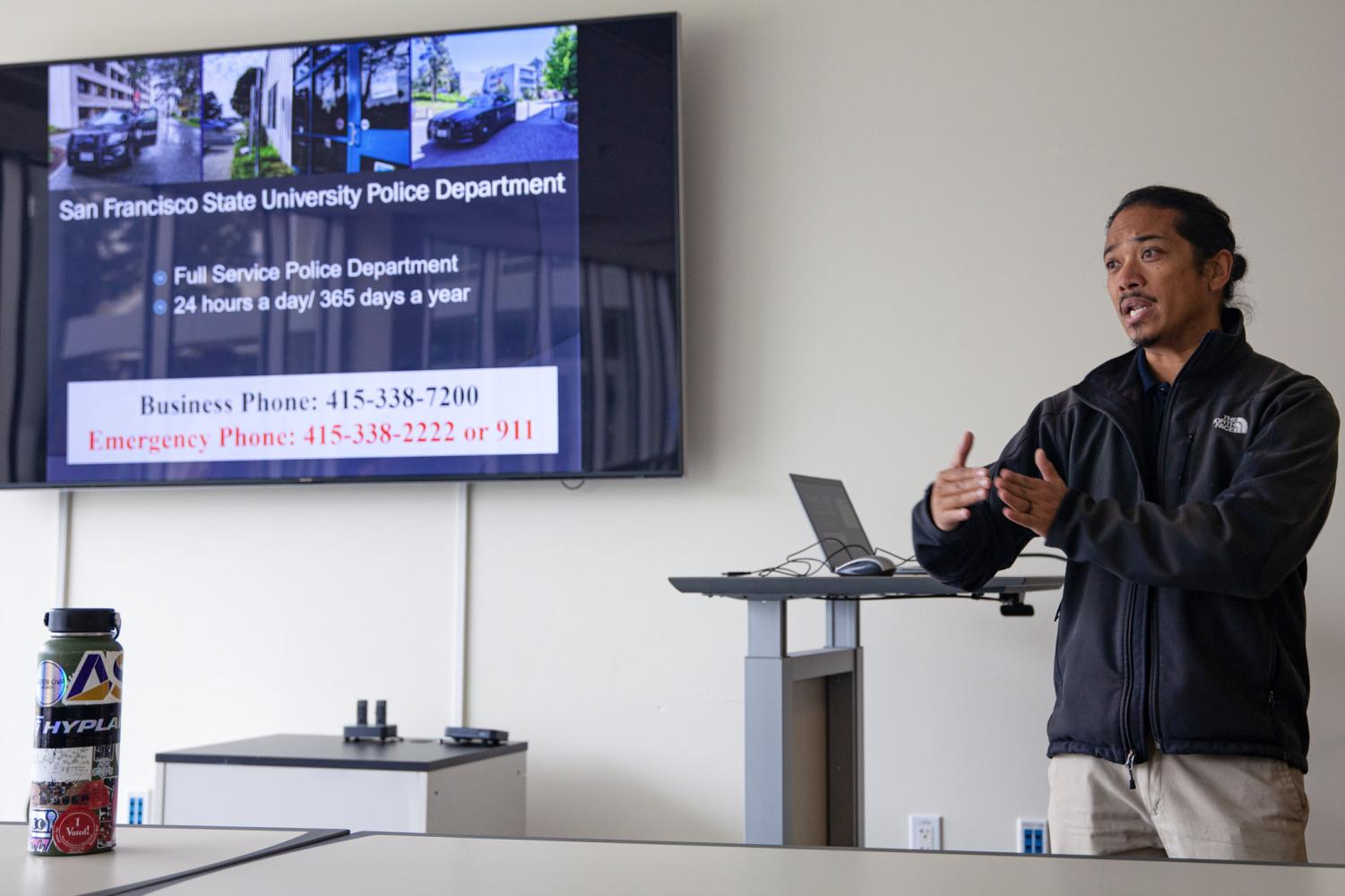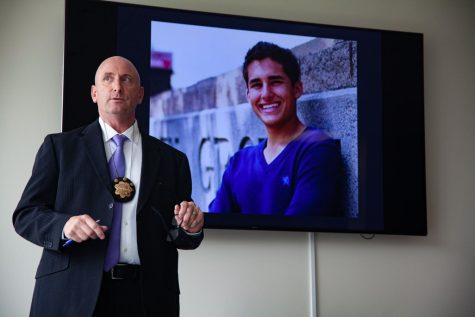



University Police and the Office of Emergency Services discussed ways to stay alert on and off campus.
October 26, 2022
University Police and the Office of Emergency Services hosted safety sessions as part of SF State’s Campus Safety Week, which began on Oct. 17.
Personal Safety & Protecting Belongings on Campus
According to UPD Crime Prevention Coordinator Mervyn Reyes, theft of personal property is the most commonly reported crime on campus and one of the most popular locations for it is at the J. Paul Leonard Library.
Even leaving backpacks on a chair to save a spot is one of the ways Reyes predicts this can happen.
“Please hold onto your bag, bring it with you,” Reyes said.
Instead, he suggests to leave a piece of paper and a pen where students intend to sit.
“You’d be surprised how fast it happens,” Reyes said.
When it’s late or students are alone, Reyes suggests to always have at least one other person to walk with. Students should also defer to busy, well-lit streets and pathways whenever possible.
“Be attentive and be aware of your surroundings,” Reyes said. “You always hear that term, but it’s true.”
Students and faculty can also request a member of UPD to walk with them through their SafeWalk 24/7 service. To use SafeWalk, call (415) 338-7200, then press 0.
UPD also releases monthly crime maps that pinpoint where crimes have been reported on campus, the type of crime and the number of times it’s been reported.
Personal Vehicle & Residency Safety
According to data from the San Francisco Police Department, there have been 5,928 reported cases of burglary from Jan. 1 through Oct. 16 across the city.
In order to protect any personal belongings in the car, Reyes suggests that it’s best to remove everything, especially valuables and keep them on hand.
“Take out everything because it gives people an opportunity [to burglarize],” Reyes said.
If that isn’t possible, the next best alternative is to store belongings in the trunk.
According to Reyes, the holidays are one of the most popular times for residential burglaries. And in order to secure your residence, Reyes said to make sure all possible points of entry and valuables are appropriately locked up.
“Secure your windows, doors, everything,” Reyes said.

Ride share Services & Public Transportation Safety
To stay safe while using ride share services, Reyes suggests double checking the license plate, model of the car and the driver from the information given once a ride is confirmed.
“I can’t tell you the amount of times people go into a car thinking it’s an Uber,” Reyes said.
To further ensure personal safety, Reyes also suggests asking the driver basic questions before entering the vehicle and sharing the trip information with someone else.
“If you feel that the person is unsafe, back out and cancel,” Reyes said.
When using public transportation, Reyes states everyone should be extra vigilant.
When using any public transportation service, such as Muni, Reyes suggests keeping backpacks, bags and other personal belongings in front and within view. Though tempting to keep out, phones should also be put away.
“Put your phones away because it’s easy for pick pocketers [to take],” Reyes said. “When it’s crowded, all it takes is a little bump.”
Hazard & Disaster Safety Overview
SF State Director of Emergency Services Hope Kaye hosted a panel on how to be prepared during emergencies and disasters.
According to Kaye, there’s a difference between the two terms.
“Emergencies are able to be managed by resources,” Kaye said. “Disasters overtake our resources.”
The first step to being prepared is knowing what risks and hazards are common in the area. This can include natural disasters, such as wildfires and earthquakes as well as accidental disasters, such as living close to chemical plants.
The San Francisco Department of Emergency Management handles natural disasters the city is more prone to such as earthquakes, wildfires, tsunamis, severe storms, flooding and extreme heat.
Individuals should also be aware of occasional risks that may happen at any time, such as power outages and extreme weather conditions.
Being Prepared at Home
Kaye suggests for individuals to be familiarized with potential household hazards. Some examples she includes are stovetops and water heaters, which can be potential gas and fire hazards.
Knowing where household utilities are and how to shut them off is also important to know before a natural disaster occurs.
“Don’t [stress yourself out] and live in a barren space,” Kaye said. “Just know how to mitigate.”
Some ways to mitigate are securing heavy items and storing fragile items in lower areas.
Earthquake Preparedness
During an earthquake, individuals are to drop to the ground, go under a table or desk if possible, cover the back of their neck and stay put until the shaking ends.
“Most injuries happen because people are moving [from place to place],” Kaye said.
After an earthquake occurs, anticipate aftershocks and follow the same protocol.
“Aftershocks can happen at any time, or not at all,” Kaye said. “Don’t stress about it. Just know that it can happen.”
She also advised to know the types of building infrastructure that are able to withstand earthquakes.
“Older homes typically aren’t bolted to the foundation,” Kaye stated
Fire Preparedness
Smoke alarms should be installed in every household. To ensure that they work, its batteries should be tested monthly.
Kaye also suggests purchasing an ABC fire extinguisher for the kitchen, as well as a fire blanket to help tame small fires.
Medical Preparedness
Kaye recommends for everyone to consider taking part in first aid training. Some examples include basic first aid, CPR/AED, basic first aid and STOP THE BLEED.
SF State currently offers an Adult & Pediatric First Aid-CPR-AED and Bloodborne Pathogens program based on American Red Cross standards. There is an online portion and a skills portion individuals must take part in to receive certification— which will be valid for two years.
Each session hosts up to 12 participants and the fees are $40 for students, $50 for faculty and staff.
The final two sessions for this year will be on Nov. 8 and Dec. 1.
Individuals should also know how to assess the needs or medical risks of the people in their households, such as asthma, allergies or diabetes. Kaye suggests having a 72 hour supply of what’s needed to aid such medical risks.
First Aid Kits & Supplies
First aid kits are important to have in the case of any emergency or disaster.
What goes into these kits is up to the individual and their families, but Kaye suggests keeping the following items handy: basic medical supplies, three days worth of food per person, one gallon of water per person per day, an AM/FM radio, flashlights, sanitation supplies, one week’s supply of necessary medications, pet supplies and activities for kids.
“Everyone’s supply kit looks different, I keep chocolate in mine,” Kaye said.

